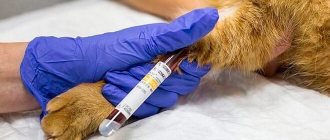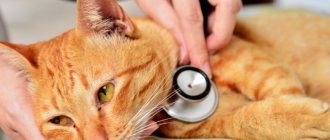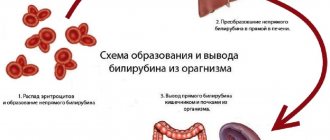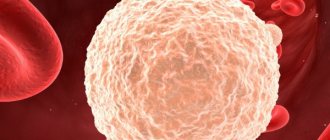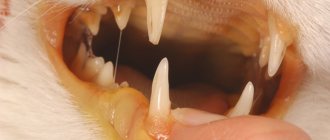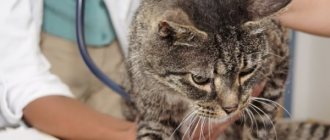Modern medicine has a huge number of methods that will allow you to determine the condition of your pet. Of course, it is better for the cat to remain healthy, but many factors can undermine the pet. A chemical blood test is one of the most important ways to identify pathologies and prescribe an effective course of treatment.
The method allows you to determine abnormalities in the functioning of the pancreas, liver or abnormalities in the metabolism. For many owners, understanding the abundance of medical phrases and terms is quite difficult. What does it mean that amylase is elevated in the blood of cats? Let's look at the issue in more detail.
What does it mean
The enzyme is required for efficient digestion of food. Most of it is produced in the pancreas. It promotes the decomposition of products in the duodenum. Based on the site of its secretion, it is also called pancreatic amylase.
The rest of the enzyme is produced in the parotid salivary glands. It, accordingly, contributes to the preliminary processing of food in the oral cavity.
Normally, amylase levels increase during daylight hours during meals. Despite the nocturnal lifestyle of cats, its number drops towards evening. The enzyme is divided into three types, but the alpha-amylase we are interested in is found only in blood plasma.
ATTENTION! Normal pancreatic amylase levels in cats range from 580 to 1600 depending on physiology.
An increase of even ten points is not critical. But if the level has increased several times, then you should definitely consult a doctor.
This is interesting: Why does a cat pull its hind legs?
Normal values
Normally, in patients over 18 years of age, the concentration of pancreatic alpha-amylase does not exceed 53 U/l. In children of the first year of life, this enzyme is synthesized in small quantities; reference values are no more than 8 U/l. Up to the age of 10, the normal values are no higher than 31 U/l, and up to the age of 18 – no higher than 39 U/l.
A slight increase in the concentration of pancreatic alpha-amylase can occur while taking corticosteroids, non-steroidal anti-inflammatory drugs, narcotic analgesics, oral contraceptives, furosemide, captopril. Therefore, to obtain reliable results, it is necessary to stop taking them if possible. Low blood test results may be caused by high cholesterol levels in the blood.
Causes and symptoms of an increased rate
Let's turn to the most serious diseases that can cause increased amylase in cats. We also note the main symptoms by which you can directly or indirectly recognize an impending illness.
Diabetes
The disease is characterized by a lack of insulin. Diagnosed in older (over 7 years old) animals, in individuals with diseases of the gastrointestinal tract or hormonal imbalances. It is important that the last point can begin with ordinary vitamin deficiency and grow into a serious anomaly.
The main symptoms of the disease are as follows:
- rapid weight loss;
- deterioration of coat condition, decrease in shine;
- excessive urination, which causes the cat severe pain;
- bad breath;
- strong thirst;
- yellowing of the oral mucosa.
The veterinarian pays special attention to amylase levels, creatinemia and hyperglycemia. Glucose in a blood test will also be overestimated. There are two types of disease. The first type involves constant administration of insulin. The second type is limited to taking medications that lower blood glucose levels.
Volvulus
Due to the lack of blood flow to the stomach due to twisting of the auxiliary organ of the mesentery, bloating occurs. A huge lump forms. Intestinal volvulus brings severe pain. The cat owner cannot do without the intervention of a specialist.
The cause may be overeating and dangerous games after a hearty lunch. Main symptoms:
- dehydration;
- hard belly, when pressed the pet purrs loudly;
- vomiting blood;
- constipation;
- depressed mood, even to the point of refusing food.
Problems with elevated amylase in cats with severe gastrointestinal trauma lead to serious problems associated with volvulus.
Pancreatitis
The disease affects cats aged 8-10 years. Most often, animals with problems with the stomach, duodenum or gall bladder are susceptible to the disease. The following symptoms are observed with pancreatitis:
- drowsiness;
- apathy;
- dehydration;
- heart rhythm disturbance;
- abdominal colic;
- vomit;
- constipation or diarrhea.
In a blood test, in addition to amylase levels, the levels of calcium, glucose, cholesterol, and bilirubin are also determined.
Kidney failure
The disease is also typical for older cats. The symptoms of the pathology are as follows:
- apathy;
- increased salivation;
- elevated temperature;
- swelling;
- loss of appetite;
- bloody diarrhea;
- Frequent urination, but the discharge is small and clear.
The analyzes pay attention to the composition of urea and magnesium. In chronic renal failure, the level of calcium in the blood is extremely low.
Peritonitis
Increased pancreatic amylase in cats leads to inflammation of the abdominal cavity. The disease has two stages. The first one is fleeting and leads to the most tragic consequences. The second, with proper treatment, will save the animal’s life, but the disease will remain a reminder of itself for the rest of its life. Symptoms of peritonitis are as follows:
- apathy, loss of appetite;
- vomiting, weight loss;
- heat;
- breathing problems;
- convulsions;
Both older individuals and very young kittens are at risk. In difficult cases, dialysis is used. It is very important to follow the strict diet prescribed by your veterinarian.
Cirrhosis of the liver
The disease is dangerous because it is almost impossible to identify it in the early stages. The following symptoms most often occur in the final stage of the disease:
- sudden weight loss;
- unsteady gait, which easily turns into convulsions;
- partial loss of vision;
- attacks of uncontrolled aggression;
- urine takes on an orange tint;
- bloating of the abdominal cavity due to fluid accumulation;
- diarrhea alternates with constipation.
Various poisonings lead to cirrhosis. Often this is a manifestation of other ailments. For example, hepatitis. Even heart disease can lead to liver problems.
Hepatitis
The cause of the disease can be poisoning and infection with microorganisms. Let's note the main symptoms:
- profuse vomiting with bile;
- loss of appetite;
- diarrhea alternates with constipation;
- feces darken and urine becomes clear;
- strong thirst.
A comprehensive analysis will reveal not only an increase in amylase, but also in iron.
Mumps
The most curable disease from the proposed list. It is most often diagnosed in young individuals and is characterized by damage to the salivary glands. Mumps can be identified by the following symptoms:
- sudden weight loss;
- fever;
- problems with salivation due to enlarged salivary glands;
- the cat experiences pain when eating or opening its mouth;
- Blood and pus are often released with saliva.
Ovarian problem
With elevated amylase in the blood, it is possible to develop cancer of the genital organs in cats. The estrus time increases significantly (up to 1 month). The female rolls around on the floor, touching her stomach with her paws.
The main symptoms include the following:
- nausea and vomiting;
- constipation;
- refusal to eat;
- excessive urination in addition to prolonged estrus;
- heavy bleeding from the genitals;
In most cases, the disease is caused by incomplete sterilization or aggressive hormonal rehabilitation.
Reasons for increased amylase in the blood
Amylase is an enzyme produced by the pancreas and parotid gland. In the body, it helps the digestion process. You can determine its amount by donating blood for biochemistry. The norm of amylase in a cat is 450–1550 units, in a dog – 680–2150 units. An increase of several units is not critical; it is worth paying attention if the indicator is several times higher.
Elevated alpha-amylase in the blood of cats can cause a number of diseases:
- Pancreatitis;
- Stomatitis;
- Pancreatic cyst;
- Neuralgia of the facial nerve;
- Intoxication;
- Diabetes;
- Hepatitis;
- Kidney failure;
- Intestinal volvulus.
There are three types of amylase: alpha, beta and gamma. The enzyme that is found in the blood is alpha amylase. In cats, it is the main one in the digestive process. It is excreted from the body through the kidneys. The most important reason to get tested is the suspicion of pancreatitis.
When elevated amylase is found in the blood, this is not a reason to panic if the pet behaves normally and is outwardly healthy. For various diseases, other indicators also deviate from the norm. The cat's behavior changes noticeably. When examining the skin, ulcers may be found. Each disease has its own symptoms. Let's look at the most dangerous ones :
Pancreatitis
Most often, cats over 8 years of age suffer from pancreatitis. Pets often get sick quietly, without giving alarm signals. The owner must be attentive to his mustachioed pet. This disease has acute and chronic forms. Obvious symptoms appear in acute pancreatitis :
- Vomiting, diarrhea, or, conversely, constipation. The stool has a sour odor;
- Pain syndrome;
- Drowsiness;
- Lethargy;
- Fever;
- Shortness of breath, shortness of breath;
- Dehydration;
- Heart rhythm disturbance.
To make a diagnosis, your veterinarian will order a blood test. If the pancreas is malfunctioning, pay attention to such indicators as: an increase in total amylase in a cat, a decrease in calcium levels, an increase in GGT, ALT, glucose, cholesterol, bilirubin.
Inflammation of the salivary glands is mumps. Young cats are more susceptible to mumps. The disease is easily treated; the main thing is to contact a specialist without delaying it. It is accompanied by :
- Rapid weight loss of a cat;
- Impaired salivary secretion occurs due to enlargement of the salivary glands;
- Fever;
- The size of the glands increases;
- Ulcers may appear on the skin;
- Pain when opening the mouth.
Diabetes
Diabetes mellitus is common in animals. Obese cats are susceptible to it. Develops due to low secretion of insulin by pancreatic cells.
Symptoms:
- Polydipsia is intense thirst;
- Sharp weight loss;
- Frequent urination;
- Lethargy;
- Stinky breath with acetone;
- Tousled hair, untidiness;
- Pets may completely refuse food, or, conversely, experience constant hunger.
When diagnosing a disease, the veterinarian looks at the levels of amylase, creatinemia, and hyperglycemia. If you have diabetes, a cat's blood test will show an increase in glucose.
As a result of allergies, infectious diseases or toxic poisoning, a cat can develop hepatitis. It can be acute or chronic. It appears as follows :
- Lack of appetite;
- Fever;
- Thirst;
- Vomit;
- Diarrhea alternating with constipation;
- The feces become light and the urine dark.
If there is liver disease, the test will show increased ALT in the cat, in addition to an increased amylase level. Their increased content can occur not only with hepatitis, but also with cirrhosis of the liver. In both cases, the iron content in the blood will be increased.
Cirrhosis is scary because it is difficult to diagnose at an early stage. Usually, once symptoms appear, it is too late to help the cat .
- Fatigue;
- Lack of appetite;
- Sharp weight loss;
- Convulsions;
- Aggression without reason;
- Impaired coordination of movements;
- Deterioration of vision.
Volvulus
For a cat, intestinal volvulus is very dangerous. The disease is fulminant. Veterinary care must be provided very quickly. Symptoms :
- Apathy;
- Vomiting, possibly with blood;
- The abdominal wall is tense, the stomach is hard;
- Dehydration;
- Frequent urge to defecate, but without results.
Kidney failure
At the beginning of the disease, the cat does not show any signs. Kidney failure goes through the first stage without symptoms. On the second, severe thirst and frequent urination begin. Animals over 8 years of age are most often susceptible to this disease. The main symptoms that should prompt an examination :
- The cat has stopped being active;
- Ulcers appear in the mouth;
- Saliva flows out;
- The cat pees very often, and its urine is light, almost transparent;
- The nose and tongue turned white;
- Constipation or diarrhea;
- Dull fur.
If the diagnosis is confirmed, the analysis will show increased levels of amylase, urea, creatinine, and magnesium. If the disease becomes chronic, there will be a decrease in calcium levels in the blood.
If an increase in total amylase is detected in a cat, this may be the cause of peritonitis, that is, inflammation of the abdominal cavity. It has two forms: acute and chronic. The acute form is fleeting, lasting from several hours to 15 days. It is not curable and ends in death. With chronic peritonitis, adhesions form, which make themselves felt periodically throughout the cat's life.
Symptoms:
- Oppression;
- Weight loss;
- Vomit;
- Severe pain syndrome;
- Vascular spasms;
- Decreased blood pressure;
- Unbreakable, high temperature;
- Abdominal retraction;
- Lack of appetite.
What test do you need to take?
To find out your amylase level, you need to take a blood biochemistry test. It can also be used to determine the content of liver enzymes, cholesterol, bilirubin and other metabolic indicators. To correctly diagnose an animal, a veterinarian evaluates all analysis data in a comprehensive manner.
Venous blood is taken from the vessels of the front paw for examination. To obtain accurate data, you must follow the following rules for preparing the sample:
- This test is taken only on an empty stomach. It is necessary to stop feeding the animal 8-10 hours before blood sampling. On the eve of the test, the cat should only be given clean water to drink.
- Animals often experience fear of veterinary procedures. Stress and anxiety can negatively affect analysis data. Therefore, you should try to calm your pet before taking blood. It is advisable to call a veterinarian at home; in a familiar environment, cats behave calmer.
- If your animal is taking any medications, you should notify your veterinarian.
How to check amylase levels
To determine the level of amylase, a cat's blood or plasma is taken for biochemical analysis. It is done to make a diagnosis, determine a treatment regimen for the animal, and control the course of the disease. The collected sample is placed in a test tube and sent to the laboratory for testing.
In order to prepare a cat for testing, you need to follow several rules.:
- Minimize stress and keep your pet calm. It is better to call the veterinarian home.
- Blood is donated on an empty stomach. You cannot feed your cat for at least 8 hours before the procedure. Otherwise, the results may be erroneous.
- If your animal is taking medications, notify your doctor.
Possible diseases
If cats have elevated amylase and there are abnormalities in other biochemical parameters, this may indicate the following pathologies:
- pancreatitis;
- diabetes;
- renal failure;
- intestinal obstruction;
- peritonitis;
- mumps;
- hepatitis;
- cirrhosis of the liver.
Making a diagnosis on your own at home is quite difficult. However, you should pay attention to your pet’s behavior in order to notice warning signs in time.
Next, we will take a closer look at possible diseases in which cats have elevated alpha-amylase.
This is interesting: How to treat a hernia in a kitten?
Causes of pathology
The most common form of pancreatitis in cats is often idiopathic. The following causes of this disease of the pancreas in cats, sometimes provoked by diseases of adjacent organs, are also identified:
- injuries resulting from falls from great heights, impacts, compression;
- surgical intervention;
- toxoplasmosis;
- viral feline peritonitis;
- feline viral immunodeficiency;
- pancreatic lipodystrophy;
- poisoning with organophosphorus compounds;
- hypercalcemia;
- long-term uncontrolled use of aspirin.
Note! For a long time, it was believed that obesity, excess fatty foods in a pet's diet, the use of glucocorticoids and diabetes mellitus are predisposing factors that contribute to the development of pancreatitis in cats. However, recent studies have shown that these risk factors are characteristic of dogs, but are not related to inflammation of the pancreas in cats.
Also controversial is the issue of the development of feline pancreatitis due to hepatitis and inflammatory diseases of the gastrointestinal tract. Modern scientific data prove that these diseases, on the contrary, are a consequence of pathologies of the pancreas.
De Ritis coefficient in dogs and cats
The coefficient in animals is determined in the same way as in humans - the ratio of two enzymes - aspartate aminotransferase (AST) and alanine aminotransferase (ALT). These enzymes are synthesized by the liver and myocardium.
Heart diseases accompanied by necrosis (infarction, ischemia) increase the level of AST in the blood by approximately 8-10 times. At this time, ALT is also increased, but less - 2-2.5 times.
If an animal has liver problems, the level of ALT in the blood increases by about 8-10 times, but AST increases by about 2 times.
The de Ritis ratio is determined by the ratio of AST to ALT. The resulting value of the indicator is determined in units/l. The norm for dogs and cats is 1.33-1.75 units/l.
Inflammation of the pancreas
This pathology is otherwise called pancreatitis. The disease can occur in acute or chronic form. Most often, older cats suffer from inflammation of the pancreas.
The chronic form of the disease can occur without obvious pathological manifestations. Acute pancreatitis is accompanied by severe symptoms:
- diarrhea or stool retention;
- unpleasant sour odor from feces;
- drowsiness and apathy;
- plaintive meowing during an attack of pain;
- frequent vomiting after eating;
- fever;
- heavy breathing.
Similar manifestations are observed during exacerbation of chronic pancreatitis.
The analysis showed that the cat had elevated pancreatic amylase, liver enzymes, cholesterol and glucose. Due to diarrhea and vomiting, dehydration occurs, so the calcium level in the blood is reduced.
Animals require a strict diet. The cat needs to be fed often, but in small portions. It is advisable to switch your pet to special medicated food. The use of painkillers, antacids and antiemetics is indicated. In case of severe dehydration, drip administration of saline solutions is necessary.
Causes of the disease
Lipase is an enzyme found in animals and humans. Its role is to break down fats that enter the digestive organs along with food. As a result of the work of lipase, fats are separated into components that are digested by the body.
Lipase is produced in the intestines, liver, pancreas and lungs. Each type of substance is aimed at “working” with its own type of fats (lipids).
The role of lipase cannot be underestimated, since in addition to the digestion of fatty foods, it is involved in energy metabolism, saturates the body with polyunsaturated fatty acids, and is also involved in the absorption of fat-soluble vitamins - A, E, D and K.
For veterinary diagnosis, only pancreatic lipase is important. In a healthy animal, there are no significant fluctuations in this indicator during the day.
A change in the amount of lipase indicates the presence of the following diseases:
- Pancreatitis in acute or chronic form.
- Cholecystitis.
- Cirrhosis of the liver.
- Stomach ulcer (with perforation).
- Renal failure (acute or chronic).
- Ketoacidosis due to diabetes.
- Small intestinal obstruction.
All these diseases pose a real threat to the health and life of the animal, and therefore require immediate seeking veterinary help.
Treatment method and prognosis
As a rule, the dog is prescribed a course of medications aimed at eliminating the underlying disease that caused the increase in enzymes. So, if the process has developed against the background of liver pathology, the drug Essentiale is prescribed, which stabilizes liver function. The dosage is determined by the veterinarian.
At the end of treatment, a biochemical blood test is done again. Enzyme levels at the same level or their increase indicate that the treatment was ineffective. In this case, there is a need for surgery to remove the affected organ.
In the postoperative period, the level of phosphatase is also increased, but this is not considered a pathology. Over time it will normalize.
During the treatment and postoperative period, the owner must strictly follow the specialist’s recommendations. Under no circumstances should you self-medicate or prescribe medications without consulting a veterinarian.
As for the prognosis, it all depends on how timely and competently the treatment (surgery) was carried out. The development of pathology leads to chronic organ diseases.
Treatment of abnormalities
Analysis of pancreatic alpha-amylase in the blood is of great diagnostic importance in gastroenterology, as well as nephrology and surgery. Its results are interpreted in conjunction with other indicators of biochemical blood tests. Most often, a gastroenterologist deals with treatment: prescribes medications, physiotherapeutic procedures, and monitors the dynamics of the disease.
Physiological abnormalities in pancreatic alpha-amylase levels in the blood can be corrected with nutrition that reduces the load on the pancreas. First of all, it is necessary to limit the consumption of fried, fatty, smoked, spicy and too sweet foods; completely eliminate alcohol, coffee, tobacco. You should eat meals in small portions. The use of any medications should be agreed with a doctor; often it is the uncontrolled use of drugs that leads to an increase in the concentration of the enzyme.
Source
When does a cat have insufficient alpha-amylase?
Problems in the animal’s body can also be judged if the analysis reveals a lack of amylase. So, if the amount of enzyme is much lower than normal, you can suspect the following ailments:
- Pancreatic insufficiency
- with insufficient production of digestive enzymes, cats may experience weight loss with a good appetite, constipation and diarrhea, which alternate (the color of the stool may be whitish, the smell - sour and fetid), flatulence, rapid heartbeat, vomiting. Most often, this disease is diagnosed in older diabetic cats;
Myocardial infarction
– with the development of necrotic processes in the muscular middle layer of the heart in cats, paleness of the skin and mucous membranes, pain in the elbow area on the left, and agitation are encountered. Most often, infarction occurs in animals with heart disease and vasculitis;
Oncology of the stomach, liver or intestines
– with cancer, cats quickly lose weight, become lethargic, eat little, and suffer from temperature fluctuations. When the liver is damaged, the mucous membranes turn yellow, and if the stomach or intestines are damaged, there may be blood in the stool, flatulence, constipation or diarrhea. More often, oncology is diagnosed in cats in old age, in animals with low immunity, in pets suffering from hormonal disorders;
Pancreatic necrosis
– when pancreatic tissue dies, cats suffer from severe vomiting, high fever, bloating, and pain in the peritoneum. The pets' skin takes on a bluish color. Most often, necrosis develops in cats with gallbladder problems, poor diet, and uncontrolled medication use;
- Hepatitis
- amylase can be reduced during diffuse processes occurring in the liver. Symptoms of hepatitis are weakness, jaundice, vomiting, and sometimes blood in the stool. As a rule, hepatitis develops against the background of advanced helminthiasis, during poisoning, or as a complication after infectious diseases.
So, we found that an increase or decrease in alpha-amylase levels in a cat's blood can signal major health problems. An experienced doctor, who will have the test result at his disposal, will help you find out exactly what disease has affected the animal.
Dangerous deviations in indicators in a cat
Deviations from the norm (increased or decreased) indicate that a malfunction has occurred in the body. Monitoring allows you to timely identify the development of the disease and begin treatment.
Bilirubin
Bilirubin is part of bile.
An overestimated value indicates the development of liver diseases (hepatosis, hepatitis), as well as blockage of the bile ducts.
Scheme of bilirubin formation in the blood
A decrease in bilirubin levels is observed with anemia and bone marrow lesions.
Total protein
An increase is observed with dehydration due to vomiting and diarrhea. A decrease in protein levels is typical for intestinal diseases, chronic liver diseases (cirrhosis or hepatitis), renal failure, and fasting.
Creatinine
An increase in blood creatinine levels may indicate the development of hyperthyroidism or kidney failure. A decrease in this value is observed during protein starvation.
Urea
An increase in urea indicates impaired kidney function and blockage of the urinary tract. Also, an excess of this value is observed when feeding your pet food rich in animal protein.
Uric acid crystals under a microscope
A decrease in urea indicates intestinal dysfunction, liver pathologies or protein deficiency in the diet.
Glucose
The reasons for increased blood glucose are as follows:
A decrease in value is observed with an overdose of insulin, prolonged fasting, poisoning with poisons or alcohol.
Blood glucose
Low glucose levels are also characteristic of pancreatic diseases.
Amylase
An increase in the rate is observed in the following diseases: pancreatitis, diabetes mellitus, peritonitis, volvulus, renal failure.
A decrease in the indicator may be the result of taking anticoagulants, poisoning, or necrosis of pancreatic tissue. The analysis determines total amylase and pancreatic amylase. The norm is 500-1200 units/l.
Cholesterol
An increase in cholesterol levels is typical for pancreatitis, diabetes mellitus, hypothyroidism and kidney disease.
AST and ALT
An increase in these indicators indicates the destruction of liver cells, which was caused by cirrhosis, hepatitis or other diseases. Also, an increase in AST and ALT can be a consequence of injury or heart failure.
Alkaline phosphatase
Increased alkaline phosphatase can occur in pregnant animals and in pets that eat fatty foods.
A decrease in the level of alkaline phosphatase is observed with anemia, vitamin C deficiency, and long-term use of corticosteroids.
Alkaline phosphatase is a whole complex of enzymes that is found almost throughout the body in small quantities.
Phosphorus
An increase in phosphorus is characteristic of leukemia and bone tumors. Also, a high value is observed in renal failure, hypervitaminosis of vitamin D, and disorders of the endocrine system.
Long-term diarrhea also leads to a decrease in the indicator.
Calcium
An increase in calcium is typical for:
- dehydration;
- destruction of bone tissue due to cancer;
- excess vitamin D.
Calcium deficiency is observed with pancreatitis, lack of vitamin D, taking anticonvulsants, and chronic renal failure.
Diabetes
Elevated pancreatic amylase in cats may be one of the signs of diabetes mellitus. Obese animals are especially susceptible to this disease. The cause of the pathology is a decrease in the production of the hormone insulin.
The owner should be wary of the following pathological manifestations in the pet:
The concentration of glucose and creatinine in the blood also increases.
Cats have two types of diabetes. In type 1 pathology, the animal requires constant and lifelong administration of insulin. For type 2 diabetes, taking pills that lower glucose levels in the body is indicated. It is also helpful to purchase a veterinary glucometer to monitor your blood sugar levels.
The role of the pancreas in the animal body
The pancreas in cats is an organ of the digestive system that performs endocrine and exocrine functions.
Endocrine functions are expressed in the synthesis of hormones that regulate carbohydrate metabolism by increasing or decreasing the concentration of glucose in the blood and tissues. These hormones include insulin and glucagon.
The exocrine function is to produce pancreatic juice, which contains enzymes for the digestion of proteins, lipids and carbohydrates.
During normal functioning of the organ in cats, the secretion of the pancreas is secreted into the duodenum, where it acts on the food bolus that comes from the stomach. However, when the gland ducts are blocked as a result of inflammation, tumor or other factors, active enzymes begin to digest their own tissues. Involvement of pathogenic microflora in the pathological process quickly leads to the development of sepsis, which causes death in cats.
Signs of low amylase
A lack of amylase can also lead to problems with cat health. Let us note some diseases and their symptoms.
Pancreas problems
Reduced secretion of amylase leads to malfunction of the digestive organs. Let us note the symptoms that lead to pathologies in the pancreas:
- loss of appetite;
- diarrhea or constipation;
- changes in the color of feces and a sour, foul odor;
- bloating and excess intestinal gas;
- cardiopalmus;
- vomit.
The disease is typical for older cats.
This group also includes necrosis of the pancreas . In fact, this is the death of living cells. It is accompanied by the following symptoms:
- elevated temperature;
- severe vomiting;
- bloating;
- abdominal pain on palpation;
The lower abdomen turns blue. The death of pancreatic cells is associated with poor nutrition, abuse of cheap dry food, and excessive use of medications.
Cancer of the digestive system
A terrible disease, of course, cannot appear only because of a low level of amylase in the blood. But the very fact of hormone deficiency can clearly indicate an incipient disease:
- the mucous membranes of the digestive organs acquire a yellow tint;
- bloody diarrhea;
- constipation;
- gases in the intestines;
On the positive side, it can be noted that older pets with weakened immunity and disruptions in the hormonal system are susceptible to the disease.
Hepatitis
Unfortunately, a lack of amylase can lead to hepatitis. Among the main symptoms it is worth noting:
- weakness, unsteadiness of gait;
- vomit;
- the mucous membrane acquires a yellow coating;
- feces with blood.
Hepatitis is often caused by poisoning and infection by pathogenic microorganisms.
Myocardial infarction
Heart problems are also a consequence of low amylase. The disease exhibits the following symptoms:
- excitation;
- mucous membranes turn white, as do individual areas of the skin;
- chest pain.
Most often, myocardial infarction is preceded by heart disease and vasculitis.
Level reduction
The reason for the decrease in the level of pancreatic alpha-amylase in the blood is a decrease in the number of normally functioning pancreatic cells. There are fewer of them with a progressive chronic form of pancreatitis, proliferation of oncological neoplasms, cystic fibrosis, pancreatic necrosis, partial or complete pancreatectomy. The reason for the decrease in alpha-amylase activity in the blood can be the use of certain drugs, for example, citrates or oxalates, as well as damage to liver cells due to hepatitis, poisoning, including alcohol, and toxicosis of pregnancy.
Intestinal obstruction
This pathology in cats occurs due to volvulus of intestinal loops. It is accompanied by pronounced symptoms:
- severe pain syndrome;
- ineffective urge to defecate;
- vomiting mixed with blood and smelling of feces;
- severe tension in the abdominal muscles.
The cause of volvulus can be too much food, frequent constipation, as well as excessive activity of the animal after eating. This is a very dangerous pathology that can quickly lead to the death of a pet. An emergency operation is required, during which the veterinarian will remove the intestinal obstruction.
When volvulus occurs in cats, amylase is increased and protein content is decreased. However, a blood test is usually not required for this pathology. This disease is diagnosed using an x-ray or ultrasound of the abdominal cavity.
Prerequisites for increasing the enzyme
A high concentration of amylase is observed in pathologies of the pancreas and disorders of other organs, which requires rational etiotropic therapeutic measures.
Increased synthesis of the pancreatic enzyme is reflected by an increase in amylase concentration by at least two times, which is accompanied by a characteristic clinical picture.
Elevated amylase in the blood is usually accompanied by the following symptoms:
- pain syndrome localized in the right side of the abdomen or directly in the right hypochondrium. The intensity of the pain increases after eating or having a light snack; bowel movements usually bring relief;
- Most often, stool disorder occurs as diarrhea. Frequent urge to defecate may be accompanied by scanty discharge, the reasons for which lie in the deterioration of intestinal motility;
- patients become lethargic and apathetic, performing the usual amount of work becomes overwhelming, night sleep does not bring a feeling of rest and recuperation.
High amylase in the analysis and these symptoms alert doctors when a patient seeks help in a hospital. The specialist understands what this means and what pathological process may be hidden behind the described clinic.
The reasons for high amylase may be the following:
- The pancreas works in an enhanced mode, which does not meet the physiological needs of the body. Excess amylase in pancreatic juice directly enters the bloodstream.
- The organ of mixed secretion can work as usual, but there may be obstacles in the way of the outflow of its enzymatic juice, which also causes an increase in the flow of amylase into the blood.
- Necrosis or traumatic injury to the pancreas or adjacent organs are conditions in which amylase is usually elevated.
Long-term study of these processes has led to the formation of specific diagnoses, in accordance with which etiotropic treatment is carried out.
Decoding the biochemical blood test in cats
A biochemical blood test allows you to evaluate the functioning of the internal organs of cats and dogs.
The following main indicators: bilirubin, total protein, creatinine, urea, glucose, cholesterol.
Enzymatic activity is assessed by: ALT (alanine aminotransferase), AST (aspartate aminotransferase), amylase and alkaline phosphatase.
Also, according to indications, the study includes indicators such as electrolytes (phosphorus, potassium, calcium, sodium, chlorine, iron) and magnesium.
The following indicators are considered normal:
| Index | Units | Norm |
| Bilirubin | µmol/l | 3-12 |
| Total protein | g/l | 54-77 |
| Creatinine | µmol/l | 70-165 |
| Urea | µmol/l | 5,4-12,1 |
| Glucose | mmol/l | 3,3-6,3 |
| Amylase | mg/(s*l) | 8-32 |
| Cholesterol | mmol/l | 1,6-3,7 |
| AST | U/l | 9,2-39,5 |
| ALT | U/l | 0-95 |
| Alkaline phosphatase | U/l | 39-55 |
| Phosphorus | mmol/l | 1,1-2,3 |
| Calcium | mmol/l | 2-2,7 |
Interpretation of clinical blood test indicators
The table shows normal biochemistry indicators, as well as an explanation of possible deviations.
| Indicator name | Norm | Demotion | Promotion |
| Total protein | 41-75 g/l | Reduced protein synthesis, hepatitis and hepatosis (chronic form), nephrotic syndrome. | Lack of water in the body, inflammation, infection, development of tumors. |
| Albumen | 22-38 g/l | Damage to the gastrointestinal tract and liver, chronic pyelonephritis, Cushing's syndrome, severe exhaustion, pancreatitis, some infections. | Severe dehydration. |
| Urea | 3.6-9.4 mmol/l | Destruction of liver tissue, lack of protein in the body. | Excess protein in the diet, kidney failure, heart attack, vomiting and diarrhea, acute anemia. |
| Bilirubin | 2.9-13.7 mmol/l | Anemia, bone marrow diseases | Liver diseases and destruction of its cells, leptospirosis. |
| Creatinine | 26-121 µmol/l | Age-related muscular dystrophy, pregnancy. | Hyperthyroidism, taking furosemide or glucose. A false increase in the indicator occurs with diabetic ketoacidosis. |
| ALT | 19-80 Units | — | Hepatitis in any form, tumors in the liver, cell necrosis, fatty liver degeneration |
| AST | 11-43 Units | May occur with vitamin B6 deficiency. | Hepatitis (acute or chronic), decreased kidney function, necrosis of heart or liver tissue, bone injuries, fatty liver degeneration. It may also occur when taking anticoagulants and vitamin C. |
| Alkaline phosphatase | 39-56 Units | Observed in hypothyroidism and anemia. | Diseases of the liver, gall bladder and ducts, bone tumors, the presence of infection in the gastrointestinal tract. It can also be increased when feeding the dog fatty foods. |
| Amylase | 684-2157 Unit. | Severe poisoning with arsenic and other poisons, death of pancreatic tissue, taking anticoagulants. | Diabetes mellitus, pancreatitis, poisoning, liver disease, renal failure. |
| Glucose | 4.1-7.5 mmol/l | Stomach cancer, lesions of the liver parenchyma, fibrosarcoma, pancreatic diseases. A decrease in glucose is also observed during insulin shock. | Cushing's syndrome, shock, diabetes mellitus, severe physical activity, heart attack, stroke, pancreatitis. |
| Cholesterol | 2.7-6.6 mmol/l | Kidney and liver failure, liver tumors, infections, rheumatoid arthritis, hyperthyroidism, malabsorption of nutrients. | Heart attack, hypertension, ischemia, liver disease, chronic renal failure, neoplasms in the pancreas. |
| Potassium | 4.2-6.3 mmol/l | Prolonged fasting, diarrhea, vomiting, muscle atrophy. | Fasting, acidosis, blood transfusion. |
| Sodium | 138-167 mmol/l | Lack of vitamin D in the body, taking certain medications (insulin, analgesics). | Dehydration, diabetes, bone tumors, chronic kidney failure. |
| Calcium | 2.1-3.5 mmol/l | Acute lack of vitamin D, pancreatitis, cirrhosis. | Bone tumors, lymphoma, excess vitamin D, leukemia. |
| Phosphorus | 1.15-2.9 mmol/l | Rickets, gastrointestinal diseases, eating disorders, vomiting and diarrhea. | Lymphoma, leukemia, bone tumors, bone fractures in the healing process. |
| Iron | 21-31 µmol/l | Anemia, cancer, recovery after surgery. | Acute hepatitis, fatty liver degeneration, lead poisoning, nephritis. |
| Magnesium | 0.8-1.5 mmol/l | Magnesium deficiency, pregnancy, vomiting and diarrhea, pancreatitis during exacerbation. | Dehydration, muscle and connective tissue injuries, kidney failure. |
| Chlorine | 96-120 mmol/l | Prolonged diarrhea and vomiting, nephritis. | Diabetes (insipidus), head injuries, acidosis. |
| pH | 7,35-7,45 | Acidosis. | Alkalosis. |
Let’s take a closer look at what each substance is responsible for and what to look for when interpreting tests in cats.
Hematocrit (HCT). Norm – 24-26%
An increased number indicates a likely increase in the level of red blood cells (erythrocytosis), dehydration, the development of diabetes in the animal, and a decrease in plasma volume in the blood.
A decrease in hematocrit indicates anemia, chronic inflammation of one of the organs, cat starvation, the presence of cancer or internal infusion.
Hemoglobin (HGB). Normal - 80-150 g/l
An elevated hemoglobin level may indicate erythrocytosis or dehydration.
A reading below 80 g/l is a sign of one of several disorders, such as anemia, obvious or hidden blood loss, poisoning, or damage to the hematopoietic organs.
White blood cells (WBC). Norm - 5.5-18.0*109/l
Exceeding the norm: leukemia, development of bacterial infections or inflammatory processes, oncology.
Decreased normal: virus, bone marrow damage, damage to the body due to radioactive radiation.
Red blood cells (RGB). Norm - 5.3-10*1012/l
An increased level of red blood cells means the development of erythrocytosis in the body, lack of oxygen, and dehydration of the body. In some cases, it indicates kidney and liver diseases.
A low red blood cell count indicates blood loss (hidden or obvious), anemia, and the presence of chronic inflammation in the body. May appear in the last stages of pregnancy.
Erythrocyte sedimentation rate (ESR). Normal - 0-13 mm/h
An increase in the erythrocyte sedimentation rate clearly indicates a heart attack, the development of cancer, liver and kidney diseases, animal poisoning, and a state of shock. In some cases, it can occur during pregnancy.
There are no reduced indicators in this case.
Neutrophils. The norm for rods is 0-3% of WBC, for segmented ones - 35-75% of WBC
With increased levels, we can talk about the development of acute inflammation (including purulent), leukemia, tissue breakdown due to tumors or poisoning.
If the level of neutrophils is low, then most likely we are dealing with fungal diseases, damage to bone marrow tissue, or anaphylactic shock in the animal.
Important: the first step to diagnosing diseases is testing.
Eosinophils. Normal - 0-4% of WBC
Take a closer look at your pet: does he have a food allergy or intolerance to medications? This is what the increased level of eosinophils indicates. Considering that the minimum threshold for this substance is 0% of WBC, there is no reduced amount.
Monocytes. Normal - 1-4% of WBC
An increase in monocytes in the blood often occurs against the background of the development of fungus in the body (including a viral nature), as well as with protozoal diseases, tuberculosis, and enteritis.
An indicator below normal occurs against the background of aplastic anemia or when taking corticosteroid drugs.
Lymphocytes. Normal - 20-55% of WBC
Increased: leukemia, toxoplasmosis, viral infection.
Decreased: presence of a malignant tumor, immunodeficiency of the body, pancytopenia, kidney and/or liver damage.
Platelets (PLT). Norm - 300-630*109/l
Exceeding the norm often indicates bleeding, a tumor (benign or malignant), and the presence of chronic inflammation. Often the platelet level increases after surgery or against the background of corticosteroids.
A low platelet count indicates infection or bone marrow disease. However, in veterinary practice there are cases when a low number of platelets in the blood is normal.
Using a biochemical blood test, you can determine the quality of functioning of internal organs. The objects of research are enzymes and substrates.
Alanine aminotransferase (ALT). The norm is 19-79 units.
An increased content may indicate the destruction of liver cells, hepatitis, liver tumors, burns and poisoning, as well as a deterioration in the elasticity of muscle tissue in the animal’s body.
A decrease in ALT levels, as a rule, has no diagnostic value. That is, if you see an indicator below 19 in the analysis, do not rush to panic.
Aspartate aminotransferase (AST). The norm is 9-30 units.
Often the norm is exceeded in case of liver disease, damage to the heart muscle or stroke. However, this can be seen not only from the analysis, but also from a visual inspection. If everything is normal with the cat, then most likely it has damaged its muscles. A reduced reading usually does not play a role in diagnosing the disease.
Creatine phosphokinase (CPK). The norm is 150-798 units.
It increases due to a heart attack or stroke, as well as against the background of muscle injuries, poisoning or coma. A reduced indicator does not affect the diagnostic breakdown.
Alkaline phosphatase (ALP). The norm for adults is 39-55 units.
An increased level of phosphatase in a normal condition of the animal may indicate pregnancy or healing of previously occurring fractures. In the presence of related symptoms, it often signals tumors in bone tissue, blockage of the bile ducts, or diseases of the gastrointestinal tract.
A reduced indicator indicates the development of anemia, hypothyroidism, and acute lack of vitamin C.
Alpha amylase. The norm is 580-1600 units.
Alpha-amylase tends to increase due to diabetes, as well as with lesions of the pancreas, renal failure or intestinal volvulus. If the indicator is below normal, then the cat is likely developing pancreatic insufficiency, which also does not bode well.
Glucose. Normal - 3.3-6.3 mmol/l
Almost always, an increase in glucose levels indicates diabetes in a cat or diseases of the pancreas. Glucose often increases due to stress or shock. In rare cases, it is one of the symptoms of Cushing's syndrome.
A decrease in glucose indicates malnutrition, poisoning or tumors.
Total bilirubin. Normal - 3.0-12 mmol/l
In 99% of cases, bilirubin increases due to liver disease (most often hepatitis) and blockage of the bile ducts. The destruction of blood cells is also possible, which is also indicated by an increase in bilirubin.
If the level of this substance in the blood is reduced, then your pet may have anemia or bone marrow disease.
Urea. Normal - 5.4-12.0 mmol/l
Did you see that the urea content in the tests exceeded the norm? Be prepared for the vet to indicate kidney failure or intoxication in the body. However, most often this indicator increases against the background of a diet rich in proteins, as well as the stressful state of the animal. Low urea content, as a rule, indicates a lack of protein in food.
Cholesterol. 2-6 mmol/l
As in humans, an increase in the level of cholesterol in the blood of an animal occurs against the background of developing atherosclerosis. In some cases, an increased rate is a consequence of liver disease or hypothyroidism. On the contrary, low cholesterol levels indicate starvation or neoplasms of various natures.
Useful materials:
- The cat has cancer Stages of mammary gland cancer in cats Like in humans, cat mammary cancer has ...
- Cutaneous horn General description of the disease Cutaneous horn on the forehead or face (ICD 10 code - L57.0) -...
- Itching and odorless discharge Main causesBefore considering the factors that provoke the appearance of discharge that has a sour odor, it is necessary to immediately note...
- Normal temperature in animals Normal temperature in different types of animals Veterinary services Day hospital for animals Veterinary certificates Vaccination…
Peritonitis
Inflammation of the peritoneum in cats is most often of bacterial or viral origin. Pathology can occur in the following forms:
- Exudative. Fluid accumulates in the abdominal cavity. This type of inflammation is diagnosed in 70% of cases.
- Dry. There is no accumulation of fluid in the abdomen. Foci of inflammation are observed in the peritoneal tissues.
The symptoms of the pathology are as follows:
- severe pain syndrome;
- vomit;
- fever (temperature is not reduced by antipyretics);
- complete refusal of food;
- diarrhea;
- abdominal retraction;
- reduced blood pressure.
The cat has increased amylase and globulins, and albumins are sharply decreased. Due to fluid loss during vomiting and diarrhea, the content of sodium, potassium and chlorine decreases.
Cats are prescribed antibiotics, analgesics and immunomodulators. For severe pain, it is recommended to apply cold compresses to the abdomen. In case of exudative form of pathology, drainage of the abdominal cavity is performed.
Clinical symptoms
Pancreatitis in cats can manifest itself in acute and chronic forms. They have significant differences in the rate of progression and symptoms. Sometimes it is very difficult for owners to understand that a cat has serious problems with the pancreas, since the clinical signs of chronic pancreatitis are often manifested only by drowsiness, rumbling in the stomach and rare bowel movements. There are times when a cat begins to hide or deliberately leave the house. This behavior is caused by the instinct of self-preservation, when the animal needs to find a reliable shelter from enemies during the illness.
Important! If the owner notices lethargy, drowsiness, or a change in the eating habits of his pet, he needs to contact a veterinarian for a full examination of the cat’s internal organs and systems.
Acute form
The main clinical signs and symptoms of acute pancreatitis in a cat, based on which a veterinarian prescribes treatment, are:
- vomiting (appears during an attack and does not bring relief to the pet);
- uncontrollable diarrhea;
- the presence of undigested food particles in the feces;
- sour smell coming from feces;
- yellowness of the mucous membranes;
- anorexia;
- tense abdominal wall;
- pain in the abdominal area;
- dry mucous membranes;
- increased body temperature;
- shortness of breath or rapid breathing caused by pain.
Important! During an attack of acute pancreatitis, cats experience such severe pain that even a very peaceful pet can bite the owner if he tries to touch his stomach or ribs.
A characteristic symptom of pancreatitis is lethargy, which occurs in 80-100% of cases. This term in cats refers to sleeping longer than usual. Together with anorexia, it should cause anxiety among owners and become a reason to contact the clinic.
Treating acute pancreatitis at home in a cat is impossible. The animal must be taken to a veterinary clinic immediately.
Chronic form
Chronic pancreatitis in cats can manifest itself as an independent disease, as well as be a consequence of the acute form.
The development of chronic pancreatitis is slow, and in the first stages it does not manifest clinical signs. The cat may periodically experience lethargy, apathy, vomiting and constipation. But after a few days, these symptoms disappear, and the owners attribute this to a temporary illness for unexplained reasons.
However, irreversible processes in the pancreas do not stop and lead to the destruction of a significant volume of the organ. The cat's appetite decreases significantly, its fur becomes dull, and lethargy sets in. When more than 60% of the gland is affected, pancreatitis in a cat becomes acute and manifests itself as a severe attack.
Significance of changes in the de Ritis coefficient
The de Ritis ratio is the ratio of AST and ALT. For a cat, the norm is 1.3 (error in both directions is 0.4). For chronic liver diseases, the coefficient varies from 1 to 1.3. If it falls below one, it means that the disease is acute. At the same time, the level of ALT increases.
The de Ritis coefficient in cats is an indicator indicating cardiac or liver pathologies
An increase in the coefficient above 1.3 indicates diseases of the heart muscle, incl. myocardial infarction. This indicator is also characteristic of liver damage from toxins.
Also, with the help of such a study, it is possible to evaluate the functioning of the animal’s internal organs, reaction to a new diet, etc. During treatment, biochemistry is performed several times to see how effective the prescribed therapy is.
Kidney failure
Kidney failure most often affects cats over the age of 8 years. The animal exhibits the following symptoms:
- frequent urination;
- discoloration of urine;
- thirst;
- swelling of the paws and body;
- blanching of mucous membranes;
- smell of ammonia from the mouth;
- sudden weight loss;
- dulling of fur;
- severe lethargy;
- frequent licking of the perineum.
As the pathology develops, the amount of urine decreases sharply. The cat has increased amylase, as well as creatinine, magnesium and urea. In the chronic form, there is a decrease in calcium and potassium levels.
Kidney failure cannot be completely eliminated. You can only achieve long-term remission. To eliminate dehydration, animals are given IVs with salt solutions and prescribed corticosteroids and potassium supplements. In later stages, diuretics are indicated. In advanced cases, dialysis must be performed regularly.
Diet plays an important role in treatment. Protein foods should be excluded from the diet. Veterinarians recommend giving sick animals special dietary foods.
Methods for diagnosing pancreatitis in cats
The subtle symptoms of pancreatitis in cats often do not allow specialists to identify the disease based only on the results of anamnesis, examination, palpation and thermometry. Therefore, additional laboratory and instrumental tests are prescribed to help make an accurate diagnosis and properly treat pancreatitis in a cat.
- A clinical blood test for pancreatitis in cats reveals an increased content of leukocytes and young red blood cells per unit volume of pathological material.
- A biochemical blood test shows elevated levels of glucose, liver enzymes, bilirubin, alkaline phosphatase, as well as decreased levels of calcium and potassium.
- Ultrasound of the abdominal cavity makes it possible to establish an enlargement of the lobes and main duct of the pancreas, diffuse blurring of the contours of the affected organ, and increased echogenicity of the parenchyma. Experts also observe thickening of the walls of the stomach and duodenum, and an increase in the volume of the gallbladder.
- CT scanning is rarely used to detect pancreatitis in cats. This is due to the special location of the pancreas, which does not allow high-quality visualization of the organ.
- Biopsy and histological examination of pathological material are the most accurate and informative methods for diagnosing pancreatitis in cats. However, obstacles to its implementation may be the impossibility of administering anesthesia, the high probability of death during surgery, or the high cost of the procedure.
- Tests to determine the level of pancreatic lipase and trypsin-like immunoreactivity in cats, the reliability of which ranges from 83 to 100%.
Note! If a biopsy is chosen as a diagnostic method for pancreatitis in cats, the specialist may suggest simultaneous collection of pathological material from the liver and intestines. This will allow us to get a complete picture of the pathology and develop more effective and comprehensive treatment.
Liver diseases
With hepatitis, biochemical blood parameters deviate sharply from the norm. The cat has elevated amylase and liver enzyme ALT. There is also a high iron content in plasma.
Unlike people, cats do not suffer from viral hepatitis. This disease in animals is of bacterial or parasitic origin. There is also a toxic form of liver inflammation that develops after poisoning.
The pathology is accompanied by the following symptoms:
- yellow color of the whites of the eyes and oral mucosa;
- severe itching;
- vomiting with bile;
- loss of appetite;
- irregular bowel movements (diarrhea alternates with constipation);
- light-colored feces;
- darkening of urine;
- thirst.
Animals are prescribed hepatoprotectors, immunomodulators and antihistamines. For the infectious form of the pathology, antibiotics are indicated, and for toxic hepatitis, the introduction of antidotes. If the disease is caused by parasites, then anthelmintic therapy is necessary.
The most dangerous liver pathology is cirrhosis. This disease is very difficult to recognize at an early stage, since symptoms may be completely absent. Signs of the disease appear in advanced cases, when it is already very difficult to cure the cat.
Most often, cirrhosis develops as a complication of hepatitis. The disease is accompanied by the following manifestations:
- bloating due to fluid accumulation;
- drowsiness;
- thirst;
- sudden weight loss;
- seizures;
- causeless aggression;
- unsteady gait;
- decreased visual acuity.
Biochemical blood parameters in cirrhosis are the same as in hepatitis.
It is impossible to completely cure cirrhosis that has already begun. In this disease, healthy organ cells are replaced by fibrous tissue. You can only stop the development of pathological changes. It is necessary to take hepatoprotectors, diuretics and vitamins. Sick cats are prescribed a diet with limited protein and fatty foods.
Mumps
With pathologies of the parotid glands in cats, amylase is increased. The cause of this is most often mumps. In humans, this disease is known as mumps. It is accompanied by inflammation of the salivary glands. The causative agent of the pathology is paramyxovirus. Often mumps occurs as a complication of stomatitis, pharyngitis or plague.
The disease begins acutely. The animal quickly develops the following signs of pathology:
- swelling of the muzzle (unilateral or bilateral);
- pain when opening the mouth;
- fever;
- increased salivation;
- formation of ulcers on the skin in the affected area;
- sudden weight loss;
- refusal of food.
In severe cases, the salivary glands become suppurated and a painful abscess appears on the skin.
Treatment of a viral infection can only be symptomatic. It is necessary to provide the cat with complete rest. It is recommended to give the animal only liquid food. Vitamin preparations and immunomodulators are prescribed, as well as warming physiotherapy. When the glands become suppurated, the abscess is opened surgically.


